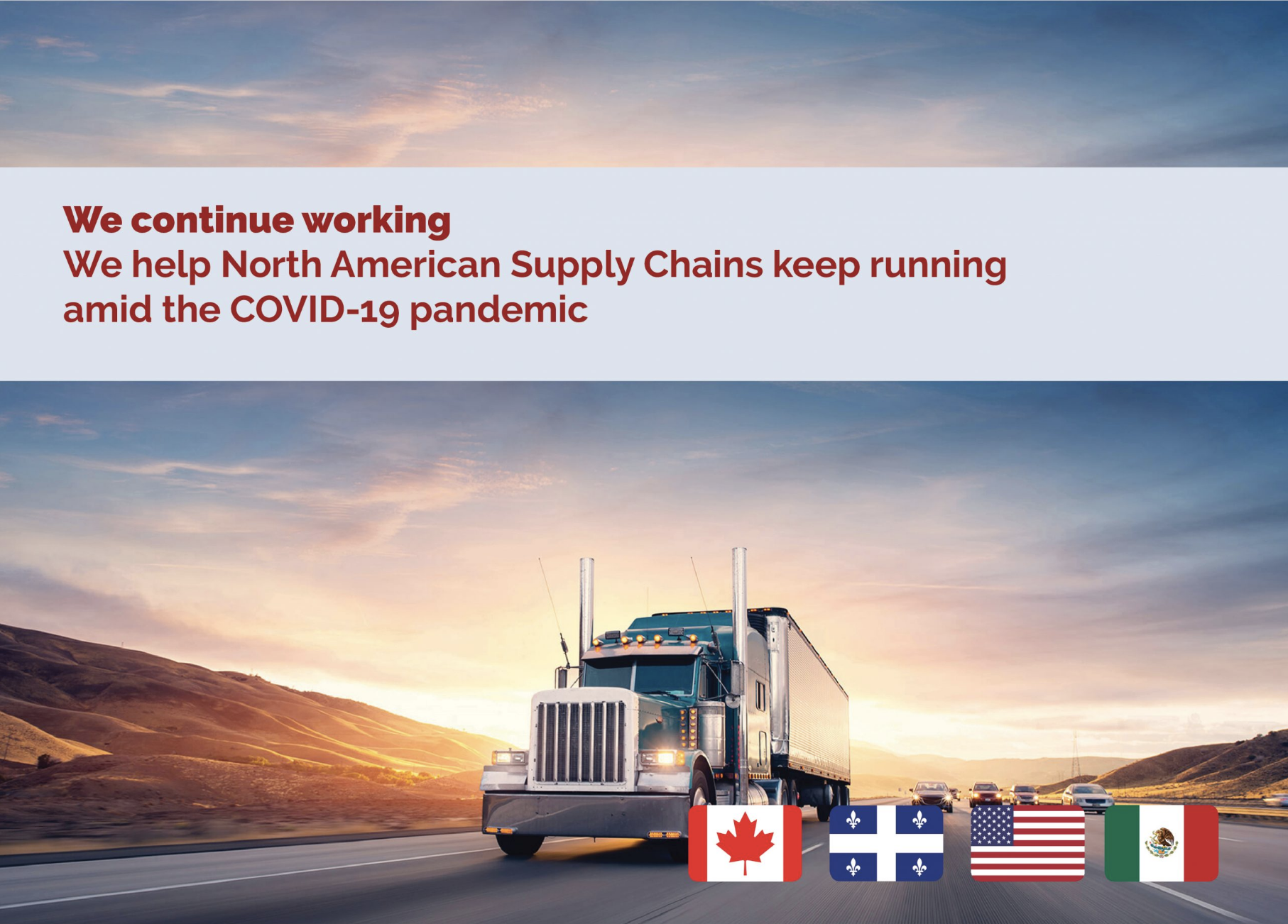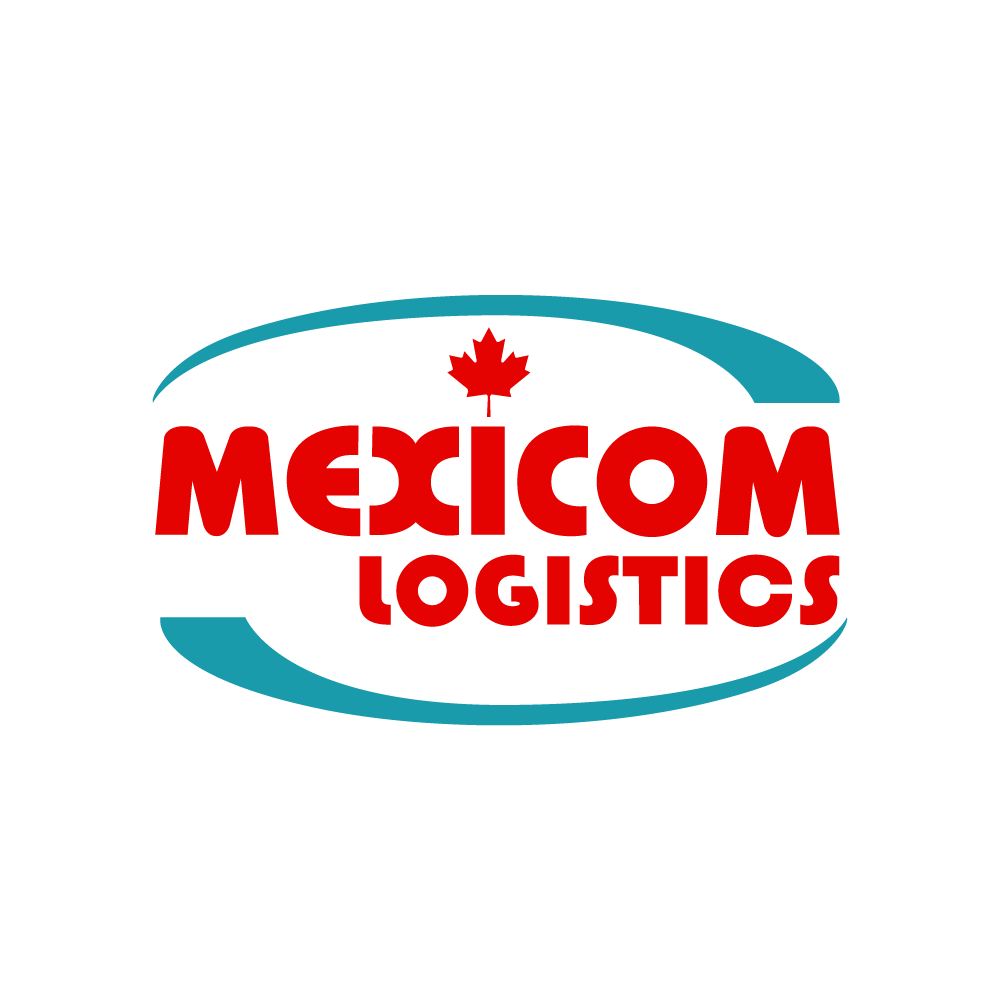Updated Guidance to limit the spread of COVID-19 in the freight transportation sector in North America
In this post, we present a complication of the resources and guidance published by the Governments of Mexico, the U.S. and Canada to protect people working in the freight transportation Industry during the COVID-19 pandemic.
Resources available by country, please click on the title to access the resources:
CANADA
- Guidance to protect drivers and limit the spread of COVID-19 in commercial vehicle operations, published by the Government of Canada.
- Jurisdictional Enforcement Interactions with Commercial Drivers – COVID-19, published by the Canadian Council of Motor Transport Administrators
- COVID-19 Tip sheet for Transportation, published by the Canadian Center for Occupational Health and Safety
- COVID-19 Tip sheets: Tips for Carriers when reviewing and updating internal policies, published by the Canadian Trucking Alliance.
UNITED STATES
- Interim Guidance for Businesses and Employers to Plan and Respond to Coronavirus Disease 2019 (COVID-19) published by the Centers for Disease Control and Prevention.
- What Transit Station Workers Need to Know About COVID-19, published by the Centers for Disease Control and Prevention
- What Mail and Parcel Delivery Drivers Need to Know about COVID-19, published by the Centers for Disease Control and Prevention
- In New York: CDC Statement on Self-Quarantine Guidance for Greater New York City Transportation and Delivery Workers, published by the Centers for Disease Control and Prevention
- What Food and Grocery Pick-up and Delivery Drivers Need to Know about COVID-19, published by the Centers for Disease Control and Prevention
MEXICO
- Sanitary protocol for cargo transportation – Recommendations for motor carriers that use warehouses and loading/unloading terminals, published by the Government of Mexico.
- Hygiene recommendations to carriers, published by Mexican Institute of Transportation. (Link to video here)
- Actions to face the pandemic of COVID-19 in the road sector, published by PIARC and the Mexican Institute of Transport
- Recommendations for Motor Carrier Operation in the face of the COVID-19 contingency published by the Mexican Institute of Transport
Recommendations provided by the Government of Canada to stop the spread of the COVID-19 in the Freight Transportation Industry:
For Fleet Managers:
- Minimize the number of vehicles shared by employees to limit the spread of the virus between different users of the same vehicles where possible.
- Ensure that drivers have access to appropriate disinfectants, hand sanitizer, personal protective equipment, and other material needed to clean high-touch surfaces in their trucks and implement recommendations made in these guidelines.
- Commercial Vehicle Operators should communicate public health recommendations and updates to drivers in a timely manner.
General Advice to Protect Commercial Vehicle Drivers:
- Commercial vehicle drivers must diligently self-monitor. Drivers with mild cough or low-grade fever (37.3 C or more) should self-isolate and stay home.
- Based on available information, it is estimated that coronaviruses can survive on hard surfaces from 24 hours to several days. Coronaviruses can be spread by touching an infected area, then touching the mouth, nose or eyes before washing hands. Hand washing and respiratory hygiene are important ways of interrupting this transmission.
- Wash hands regularly and whenever they become soiled:
- Hand washing with plain soap and water is the preferred method of hand hygiene, since the mechanical action is effective at removing visible soil and microbes.
- Hands should be washed using soap and warm water for at least 20 seconds. When drying hands, disposable paper towels are preferred.
- If soap and water are not available, an alcohol-based hand sanitizer (ABHS) can be used as a temporary measure until hand washing can be done. ABHS containing 60-90% alcohol concentration (optimally over 70%) are the most rapidly active of all agents used in hand disinfection. However, ABHS may not be effective when there is organic material on your hands (e.g. after using the toilet). For this reason, ABHS alone should not be used on visibly soiled hands. Use wipes to remove soil, followed by ABHS.
- Avoid touching eyes, nose and mouth with unwashed hands.
- When coughing or sneezing drivers should:
- cough or sneeze into a tissue or the bend in the arm, not into hands; and
- dispose of any tissues that have been used as soon as possible in a lined waste basket and wash/sanitize hands for 20 seconds afterwards.
- Face-to-face meetings should be kept to a minimum and respect social distancing requirements. To the extent possible, face-to-face meetings should be replaced with conference calls or video conferencing. Interactions with clients should also be kept as short as possible keeping in mind social distancing requirements.
Before Each Trip
- Commercial vehicle drivers should monitor their health prior to starting a trip. If a driver is experiencing symptoms, even if they are mild cough and fever, they should stay home and advise their employer so steps can be taken to protect co-workers.
- Make sure vehicle interiors are clean and hygienic by wiping surfaces with disinfectant.
- The following equipment should be available for cleaning:
- Personal protective equipment (as required by the operator’s health and safety protocol);
- Disposable cloths;
- Paper towels and absorbent materials;
- Waste disposal bags, labels and tape;
- Cleaning agents; and
- Disinfectants.
- Cleaning is a critical first step for disinfecting affected surfaces. In general, when cleaning vehicle interiors:
- Put on disposable, water-proof gloves. Avoid hand contact with the face, especially the nose and eyes. Direct contact with contaminated areas should be avoided.
- For routine cleaning and disinfection, and for areas potentially contaminated with COVID-19, a hard-surface disinfectant authorized by Health Canada is recommended. For a list of hard-surface disinfectants for use against coronavirus (COVID-19), please see Health Canada’s website.
- Follow the manufacturer’s instructions for the recommended dilution rates, contact times and conditions specific to the surface.
- Avoid bleach except on simple plastics.
- Don’t use solvents.
- Wipe off what you wipe on; don’t leave chemicals to linger.
- High touch surfaces in trucks that should be regularly cleaned include but are not limited to:
- Keys or FOBs;
- Starter button on vehicles with FOBs;
- Inside and outside door handles; Inside door grab handles, pads and armrests;
- Steering wheel;
- Shift lever and console;
- Dashboard;
- Power window and power door lock switches;
- Radio and climate control buttons;
- Turn signal and wiper stalks;
- Seat and Seat adjuster;
- Touch screen; and
- Any other parts that are commonly used and that may have been touched (glove compartment, hood, trunk, van panel door handles, pick-up tailgate handle, sleeping areas, for example).
- Dispose of soiled cleaning clothes, disinfection cloths, disposable gloves and any other items in contact with respiratory tract secretions in a waste disposal bag.
- Wash hands when finished using proper hand washing techniques.
During the Trip
- Commercial vehicle drivers should wash their hands frequently under warm, running water with soap for at least 20 seconds, and avoid touching their faces with unwashed hands. This is especially important after coming in contact with other people or surfaces that may carry the virus. When soap and water is not available, a 60% alcohol based hand sanitizer is recommended.
- Commercial vehicle drivers should take precautions such as covering their hands when pumping gas, touching the service station door handles, or handling any automotive products that may be required when performing vehicle maintenance, such as filling windshield washer fluid and adding motor oil, if this is possible. If it is not possible, commercial vehicle drivers should wash their hands or apply hand sanitizer immediately thereafter, if available.
- As much as possible, social distancing practices should be observed, staying at least two metres (or six feet) away from other people. Commercial vehicle drivers should keep appropriate distances between themselves and others and avoid direct physical contact (including handshaking). This includes contact with customers, receiving personnel and those at rest stops.
At the End of the Trip
- Repeat a thorough cleaning of high-touch surfaces with appropriate disinfectants as described above.
- Drivers who start to experience symptoms after completing a trip should stay home, self-isolate, and advise their employer so that additional steps can be taken to protect co-workers and other drivers using the truck.
- While commercial vehicle drivers are exempt from the 14-day quarantine requirements for business purposes, when off-duty, they should abide by recommendations of local and national public health authorities, including recommendations relating to social distancing.
Jurisdictional Enforcement Interactions with Commercial Drivers – COVID-19
- During initial contact, direct the driver to remain in the vehicle during the inspection (unless otherwise specified by the officer) and where possible, maintain appropriate “social distancing” (2 metres) from the driver.
- Please limit scale building access to staff only.
- Avoid stepping up on vehicle running boards or entering the driver cab by having the driver verbally report information and observe the driver demonstrate proper function of equipment with the officer standing at a distance (e.g. air pressures, dash warning lamps, seatbelt function, steering lash etc.).
- Use discretion when exchanging documents for inspection and limit exchange wherever possible. If possible, request verbal transmission of information for completing reports etc. (e.g. verbally transmit driver license number).
- Where physical document transfer does happen, ensure proper hygiene precautions are being followed immediately after (e.g. exchange gloves/wash hands/sanitize work surfaces).
- Do not request that the driver sign documentation (e.g. ticket, inspection report).
Mexicom Logistics is following the recommendations provided by the
Government and Health Authorities at its offices and warehouses located in Canada, the U.S. and Mexico.

International freight transportation services
between Mexico, the U.S. and Canada.
Request a quote: info@mexicomlogistics.com









